Shady Things About Olive Garden's Menu
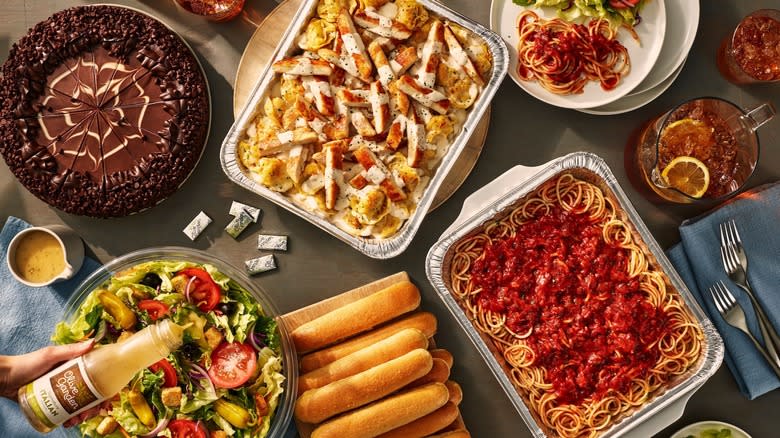
Olive Garden is one of Americans' favorite places to eat out, whether it's for a weekday dinner, casual lunch, or special occasion. Evoking homestyle favorites and a generalized Italian sensibility in serving up pasta dishes, fried appetizers, and decadent desserts, it ranks with the likes of Red Lobster and The Cheesecake Factory as one of the most popular and indulgent restaurants found in hundreds of cities across the United States. (Texas in particular is home to the most Olive Gardens in the country.)
But alongside the simmering red sauce, flavorful meatballs, and baskets of warm and buttery breadsticks, Olive Garden's kitchens offer some uncomfortable truths and unpalatable secrets. To serve hundreds of customers a day as quickly, efficiently, and consistently as possible, the chain has to run like a well-oiled machine. Numerous corporate-ordered procedures are in place to make Olive Garden both pleasant and popular. Many of these standard operating procedures disappoint those who think Olive Garden is a unique eatery, or are expecting a scratch-made meal like they'd find in a quaint kitchen in an idealized Italy. Here are the most discomfiting and shady things about Olive Garden's legendary food, including the famous breadsticks and salads.
Read more: The Most Overrated Chain Restaurants In The US, According To The Mashed Staff
Olive Garden Doesn't Salt Its Pasta Water
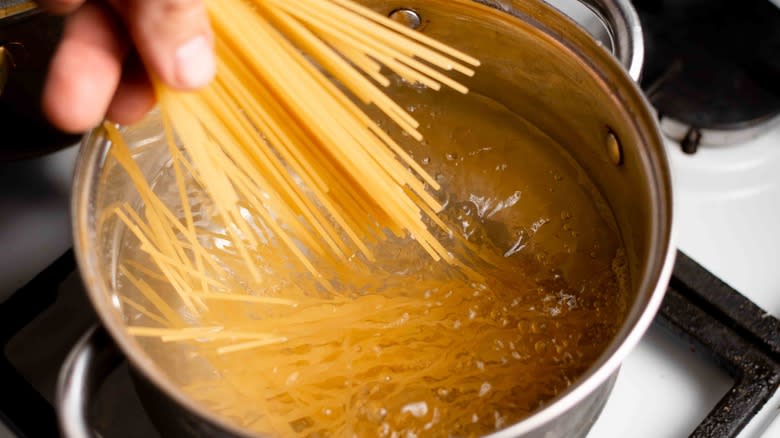
In 2016, investment group Starboard Value LP seized control of Darden Restaurants, the parent company of Olive Garden. To improve the quality of Olive Garden's products and increase profitability, Starboard Value's financial experts recommended the restaurant's kitchens chain-wide should institute an easy, inexpensive, and traditional preparation tip to make its staple menu item, pasta, taste better: add salt to the water at the beginning of the cooking process. Olive Garden, which purports to offer customers a homemade-style dining experience, never did this before the Starboard Value takeover.
It didn't adopt the procedure afterward either. Salt can rust and corrode kitchen equipment over time and cause pitting, so internal research at Olive Garden suggested that using salt in its pricey pots and pans would void the warranties on the gear. The board of directors decided that Olive Garden's final, composed dishes tasted fine enough without adding salt.
But You'll Still Get Plenty Of Salt At Olive Garden
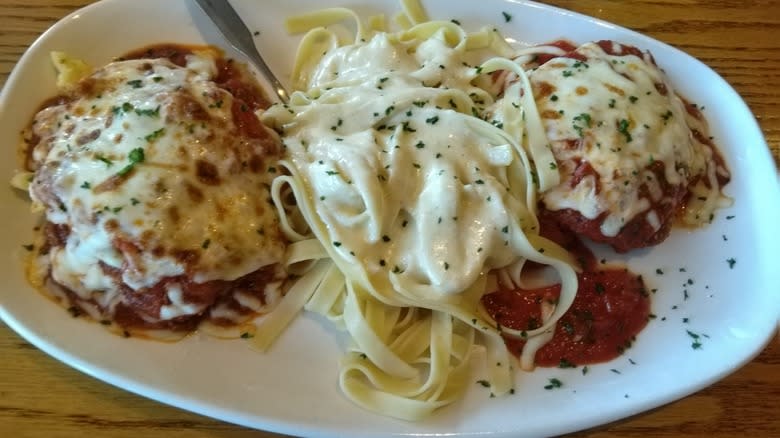
Chain restaurant food (particularly, abundant portions like Olive Garden serves) is widely understood to be less than healthy and rife with fat, calories, and sodium. Olive Garden is especially guilty of including too much of the latter across its sprawling menu; the food is unequivocally loaded with salt. Several popular favorites at the chain contain more sodium than the United States Department of Agriculture (USDA) recommends a person should consume over an entire day.
The USDA's official guideline on sodium intake is to limit consumption to under 2,300 milligrams per day. Olive Garden dinner menu items like the Chicken Parmigiana (3,300 milligrams), Tour of Italy (3,220 milligrams), Chicken Marsala Fettuccine (2,580 milligrams), and the Chicken Tortelloni Alfredo (3,720 milligrams), one of the unhealthiest chain restaurant chicken dishes of all, all exceed the USDA's figure. Some appetizers, intended to be just part of the larger meal experience, provide more than enough sodium for a day, like the Meatballs Parmigiana (2,800 milligrams) and the Spinach-Artichoke Dip with Flatbread Crisps (2,440 milligrams). The single saltiest dish on offer at Olive Garden is the Shrimp Fritto Misto appetizer, packing in two whole days' worth of sodium with 5,010 milligrams.
The Many Secrets Of Olive Garden Breadsticks
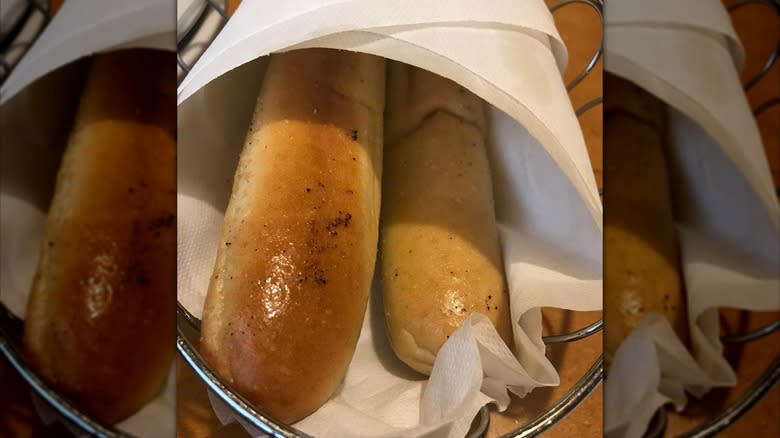
Olive Garden's breadsticks are delicious, widely beloved, and easily the chain's most famous contribution to American cuisine (the free refills with your meal don't hurt either). They may taste magical and go great with reliable, restaurant-made Italian-American fare, but they're also extremely simple to make. (There are even some legitimate copycat Olive Garden breadstick recipes.) It's just white bread dough, shaped into a cigar and brushed with a garlic butter sauce that consists mostly of margarine and garlic salt. Olive Garden doesn't actually make its most notable concoction in-house, partnering with commercial bakeries located near its restaurants to prepare and partially bake all those breadsticks. The semi-cooked breadsticks arrive at each Olive Garden daily, where the staff heats them just before serving.
As for their unlimited nature and to ensure that each restaurant doesn't run out of its supply or have to throw out any uneaten ones (and contribute to costly food waste), they're distributed in a particular way. After diners order their entrees — and not before, to prevent customers from eating bread and leaving — they're given a basket containing the same number of breadsticks as there are people in their party, plus one extra.
It's Not Always Authentically Italian
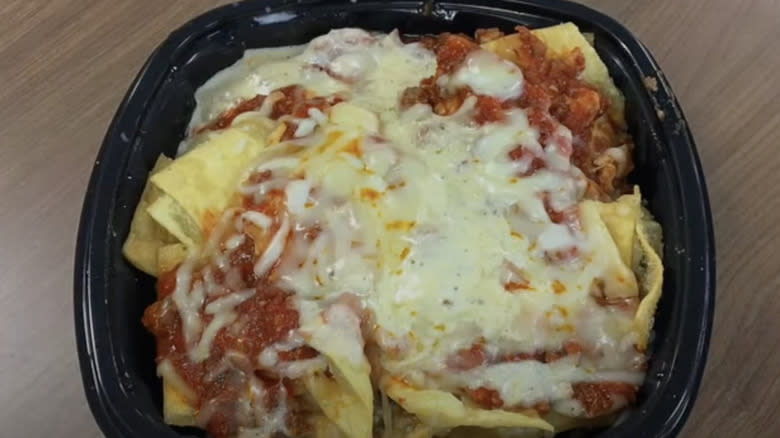
Olive Garden proclaims itself to be an Italian restaurant, but its food is definitely more of the Americanized or Italian-inspired variety. Popular picks like Chicken Parmigiana, Fettuccine Alfredo, and Spaghetti and Meat Sauce aren't painstakingly authentic, but Olive Garden doesn't purport them as such. In the 2010s, the restaurant chain attempted to position itself as the real deal with the introduction of several new menu items with Italian-sounding names marketed as obscure, gourmet, Italian dishes. (Which is to say nothing of its briefly available Loaded Pasta Chips, an Italian-style take on nachos, built with a base of chips made from fried lasagna sheets.)
Olive Garden pushed Soffatelli and Pastachetti most of all. The Soffatelli was a series of entrees consisting of a puff pastry shell loaded with a blend of cheese and herbs and topped with chicken and a creamy garlic sauce or braised beef in a balsamic sauce. The Pastachetti was an elaborate, multi-layered take on lasagna. Neither concoction came from Italy anyway — both were invented in Olive Garden kitchens and given names to sound Italian that were ultimately meaningless.
The Pasta Is Made Ahead Of Time
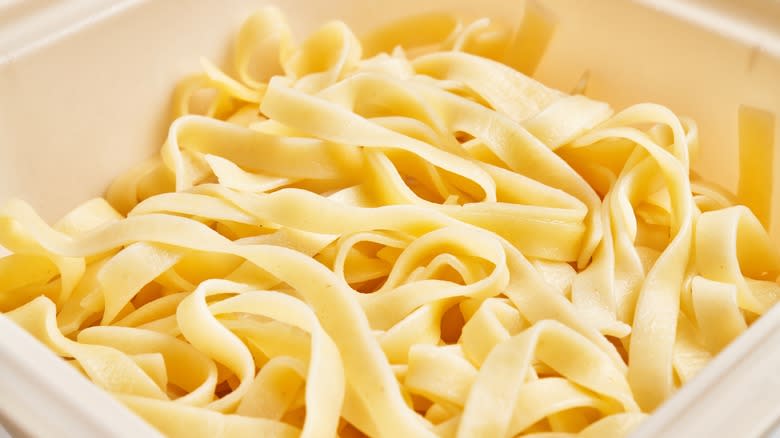
The pasta and noodles that form the foundation of most entrees at Olive Garden may arrive at diners' tables hot and steaming, but that doesn't mean they're fresh. Chances are, the pasta was cooked many hours before. The average Olive Garden handles so many customers every day that food prep occurs on a massive scale. It would take too much time and kitchen space to boil water for each of the countless pasta orders. Instead, the staff pre-cooks all the pasta for the day first thing in the morning. It's then placed in an ice bath and transferred into portioned bags (for special pasta types) or a massive vat (for high-volume noodles like fettuccine and spaghetti).
When a customer orders their dish, the staff gets to work reheating the pasta. Pots of water are kept boiling all the time at Olive Garden, and cooks can just throw a measured portion of pre-made pasta into the water, getting it ready for serving in just a couple of minutes or less. Then it's strained, plated, and topped with the appropriate sauce.
Some Of The Food Gets Microwaved
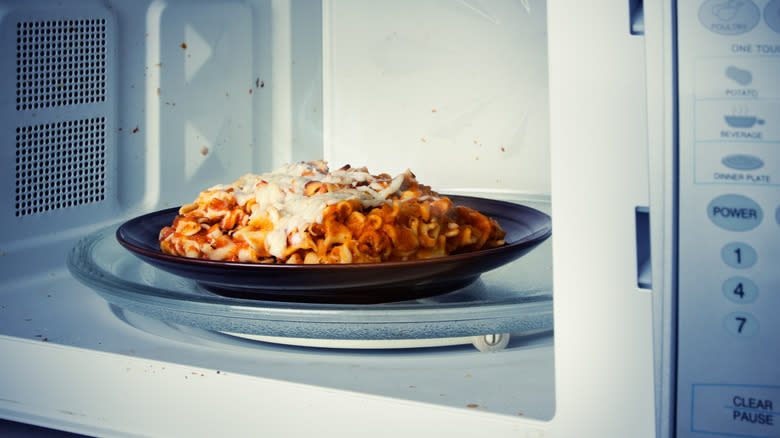
The average Olive Garden has to serve a restaurant full of customers through lunch and dinner hours, and it needs to utilize time-saving measures to ensure diners aren't kept waiting unreasonably long for their meals. Every Olive Garden kitchen is equipped with at least three microwaves that can heat or cook most foods in a much shorter time than an oven or range top. That's not quite providing a top-level restaurant experience, or one that will make food taste the best it can, but it's a process Olive Garden uses for several of its offerings.
The chain uses the microwave to speed up the cooking times for potato items, hot vegetables (most notably broccoli), as well as for some sauces and meat portions. A former employee made a TikTok video (via Newsweek) and compared the Olive Garden meal preparation process to "a Hamburger Helper Italian kind of thing," with convenience and shortcuts driving many kitchen procedures.
Despite depending on multiple microwaves in its restaurants, Olive Garden attests that many of its menu items are freshly prepared the same day on the premises, notably the variety of soups and pasta sauces. The meat used in various entrees arrives frozen at each restaurant and is cooked on the premises as needed.
The Salad Is Carefully Managed
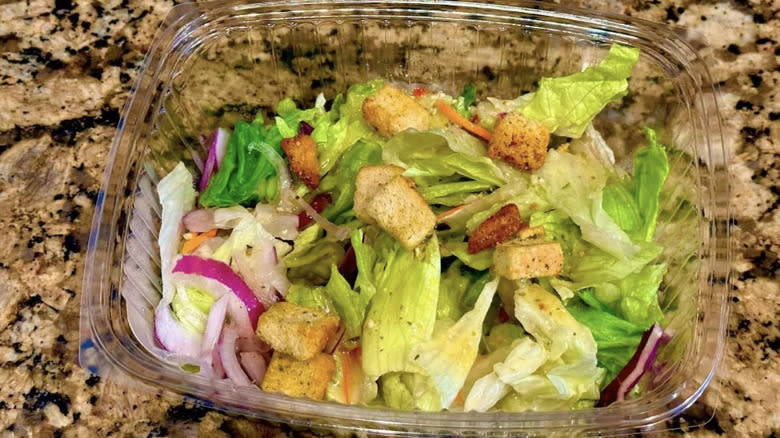
Just as the complimentary breadsticks at Olive Garden are unlimited, within reason and subject to a strict set of rules, the also free-not-totally-free pre-meal salad is also doled out with parameters secretly coming into play. While it may appear without fail that a server plops down that giant bowl of salad (a romaine mix with a smattering of red onions, croutons, black olives, pepperoncini, and tomatoes slathered in tangy Italian dressing), it's all been measured and assembled based on the number of people in the dining party.
Olive Garden is stingy with the more expensive ingredients, namely olives, tomatoes, and peppers. The more people sitting at one table, the more croutons and specialty vegetables and toppings they'll get in their salad. They can certainly order as many more bowls as they want — it's unlimited, after all — but the exact permutation of salad ingredients will likely always be the same.
Customers don't even have to go to Olive Garden and buy an entree to gain access to that salad. The one-of-a-kind Italian-style dressing is sold in grocery stores. The recipe has remained unchanged for decades, and what's sold in stores is the same stuff used in the restaurants.
Olive Garden Is Lying About Parmesan
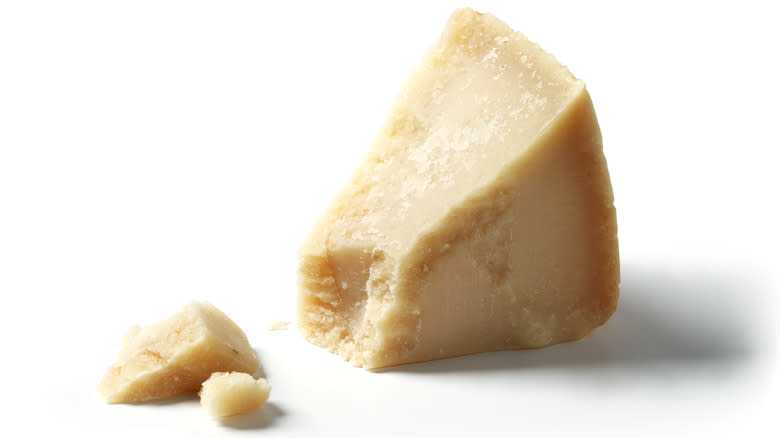
Olive Garden operates under an all-you-can-handle Parmesan cheese policy. Servers wielding white plastic shredders will grind down a hunk to provide customers with as little or as much salty, tangy garnish as they want. While that remains one of the most generous and tasty practices at Olive Garden, it's something of a lie — diners don't really get unlimited Parmesan cheese because that cheese isn't actually Parmesan.
Across the chain for table-side purposes, Olive Garden uses Lotito Romano, an Italian cheese with a taste and texture similar to Parmesan. What's the most important difference, as far as Olive Garden is concerned? The Romano variant is much cheaper than Parmesan (especially the authentic stuff which is different from the American version). The Lotito Romano cheese does the trick and only someone with a hyper-attuned palate for cheese will notice. Nonetheless, it's a dishonest cost-cutting measure. Similarly, the Chicken Parmigiana entree recipe doesn't employ Parmesan at all — it's made with American-style mozzarella.
The Fettuccine Alfredo Is Not As Fresh As You Think
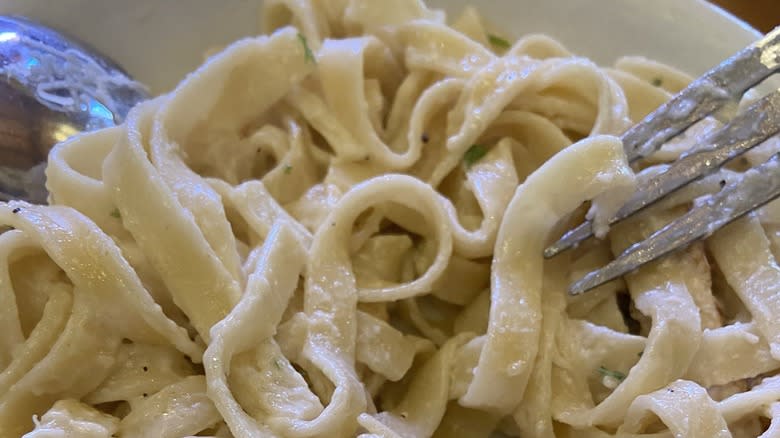
As a signature menu item, Olive Garden's Fettuccine Alfredo is a crowd-pleaser. Consisting almost entirely of thick noodles, a creamy and cheesy sauce, and grilled chicken on top for an extra charge, it's an extremely simple dish. It's even more basic and easy to prepare than Olive Garden customers would think. It takes less than a minute to make, according to Olive Garden kitchen workers, making it an even faster dish than most fast food — but at a significantly higher cost than a burger combo.
The entree begins with pasta, and since Olive Garden cooks all of its most-used noodles in advance in large batches, all a cook has to do to get the fettuccine ready is pull it out of a holding vessel and give the right portion a quick bath in boiling water to bring it up to a warm serving temperature. Then it's topped with pre-cooked Alfredo sauce, kept constantly available because Olive Garden sells so many meals that use the stuff. The total amount of time required to make Olive Garden Fettuccine Alfredo is about 20 seconds. Servers often wait to put in orders to the kitchen on that item to give cooks a head start on prepping other dishes ordered by the table and ensure everything is ready at the same time.
Olive Garden Quietly Makes Use Of Many Secret Ingredients
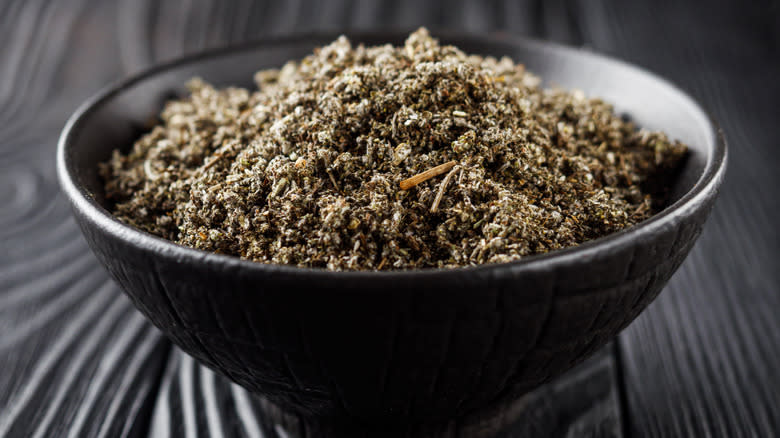
Italian food, particularly the kind of Italian-suggesting fare served at Olive Garden, is very reliant on flavorful sauces. Some of the ways the restaurant company's kitchens have devised those sauces aren't necessarily gross, just a bit mundane and a little surprising. Across its menu, Olive Garden offers four sauces, but most options are built around a marinara or Alfredo base. And then there's the proprietary five-cheese blend. If it seems like the latter is part red sauce and part cream sauce, that's because it is — it's just the chain's two chief sauces mixed together to create something seemingly new.
Then there are Olive Garden's meatballs, which feature in the Meatballs Parmigiana appetizer and can be added to most pasta entrees. Despite the strong taste of pork, none of the meatball-based menu items contain it. Olive Garden's menu mentions that its meat sauces contain Italian sausage, which is categorically made with pork. But Olive Garden's meatballs don't include it, instead utilizing the spices that create the Italian sausage flavor profile while omitting the pork. A mixture of Italian seasonings, mostly marjoram, sage, and thyme, provide the familiar taste.
The Gluten-Free Pasta Isn't Necessarily Gluten-Free
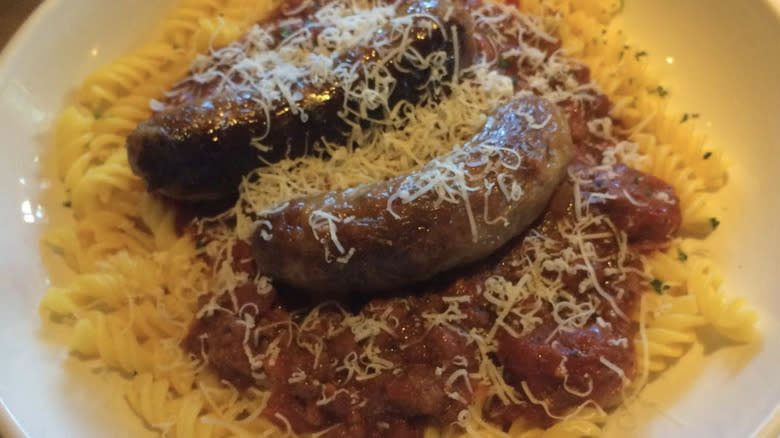
Many people avoid gluten in their diets for a variety of reasons. As pasta is primarily made with wheat flour, there aren't a lot of gluten-excluding choices on the menu at the pasta-forward Olive Garden, but the chain makes its nutritional information available with a Q&A and warnings for its customers on a "Gluten Sensitive Diet."
While confirming that its gluten-free pasta option is made from brown rice flour and, with another nod to safety, cooked in different pots than its wheat-heavy pastas, the restaurant suggests that gluten-free customers proceed at their own risk. "The menu items we call 'gluten sensitive' are our menu items that are made without gluten-containing ingredients," the fine print reads. "We do not claim these items are 'gluten free' because we have not chemically analyzed them to confirm if they meet the Food and Drug Administration's (FDA) definition of 'gluten free' (20 parts per million of gluten)."
Olive Garden Is Ambivalent About Nut Allergies

Olive Garden makes an allergen guide available for customers , listing which menu items contain potentially problematic elements like dairy, eggs, fish, shellfish, tree nuts, and peanuts. Only one item at Olive Garden contains nuts of any kind — the Almond Biscotti, a small cookie given out with the specialty coffees on the dessert menu. Nevertheless, Olive Garden may still not be a safe place to dine for people with nut allergies.
In a letter sent to a customer and published on Allergy Eats, Olive Garden's customer service department admitted that it couldn't ever guarantee that its kitchens were free of nuts, while also absolving itself of responsibility. "Identifying allergens is a complex process for restaurants as there may be minuscule amounts of ingredients our vendors may not list," Olive Garden's representative wrote. "As you know peanuts have been hidden in pie crusts, gravies, chili, spaghetti, soups, and cheesecakes." Because it can't control and doesn't test everything that its vendors provide, Olive Garden doesn't proclaim itself to be entirely nut-free.
Olive Garden Knowingly Added A Common Allergen To The Breadsticks
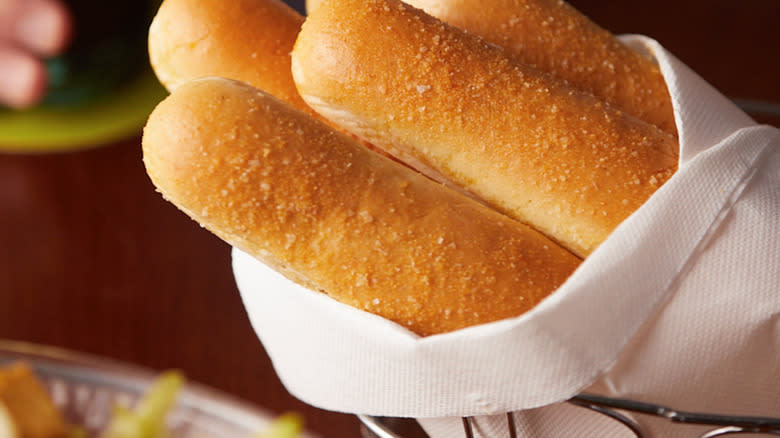
Until the end of 2022, Olive Garden's complimentary breadsticks didn't contain sesame. But to be compliant with the FASTER Act that went into effect on January 1, 2023, signed into law by President Joe Biden, the restaurant altered its breadstick recipe by adding sesame to the flour. One stipulation of the new allergen labeling law: Food manufacturers had to clearly inform customers if a product contained sesame. Rather than run the risk of sesame found in other menu items contaminating its breadsticks, or take the arduous steps necessary in its restaurants' kitchens to prevent that contamination, Olive Garden deliberately put sesame into the breadstick mix. That way, they could just label the breadsticks as definitely containing sesame to keep customers allergic to that ingredient away.
After diners noticed the recipe for one of its most popular items changed, and to skirt a complicated food allergen labeling law, Olive Garden changed flour suppliers. By the end of 2023, sesame-free breadsticks returned to Olive Garden, although the chain's allergen guide warns that cross-contamination could be possible at supplier facilities.
Read the original article on Mashed

